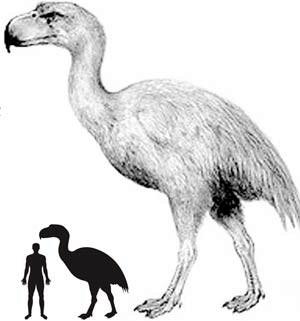REAL WORLD CREATURES
PHORUSRHACIDS
Val CHA Cost Roll Notes 25 STR 15 14- Lift 800 kg; 5d6 HTH Damage [2] 15 DEX 15 12- OCV: 5/DCV: 5 20 CON 20 13- 13 BODY 6 12- 5 INT -5 10- PER Roll 12- 10 EGO 0 11- ECV: 3 15/25 PRE 5 12- / 14- PRE Attack: 3d6/5d6 10 COM 0 11- 7 PD 2 Total: 7 PD (3 rPD) 7 ED 3 Total: 7 ED (3 rED) 3 SPD 5 Phases: 4, 8, 12 9 REC 0 40 END 0 40 STUN 4 Total Characteristics Cost: 70 Movement: Running: 15"/30" Leaping: 5"/10" Swimming: 2"/4" Cost Powers & Skills 5 Horrid Screech: +10 PRE; Only To Make PRE Attacks, No Effect Versus The Deaf (-1) 30 Axe-like Beak: HKA 1d6+1 (2 1/2d6 w/STR), Reduced Endurance (0 END; +1/2) 18 Wing Spurs: HKA 1d6 (2d6 w/STR), Reduced Endurance (0 END; +1/2); Reduced Penetration (-1/4) 15 Kick: HA +3d6, Reduced Endurance (0 END; +1/2); Hand-To-Hand Attack (-1/2) 3 Tough Feathers: Damage Resistance (3 PD/3 ED) 18 Powerful Legs: Running +9" (15" total) 2 6 Predator's Senses: +2 PER with all Sense Groups 5 Large Eyes: Nightvision Skills 3 Skilled Predator: +1 with any Strike 3 Concealment 11-; Self Only (-1/2) 3 Stealth 12- Total Powers & Skill Cost: 109 Total Cost: 179 75+ Disadvantages 15 Physical Limitation: Animal Intelligence (Frequently, Greatly Impairing) 5 Physical Limitation: Large (-2 DCV) (Infrequently, Slightly Impairing) 15 Physical Limitation: Very Limited Manipulation (Frequently, Greatly Impairing) 69 Experience 226 Total Disadvantage Points

Ecology: Native to Central and South America during the Cenozoic era from 62 to 2 million years ago. They are large, flightless predatory birds. It is possible that they crossed into North America using the Panama ithmus land-bridge but if this is the case siginificent amounts of remains had not yet been found.
Personality/Motivation: The apex predator of its time, the primary motivation of the bird is to catch, kill and eat anything smaller and slower than itself. Since modern humans are unknown to this creature characters will likely be mistaken for a tasty meat snack. If the bird is hungry it will likely attack humans on sight.
Powers/Tactics: There is dispute among the scientific community about how these animals hunted. The majority believe that they are swift solitary hunters which ran down their prey. Some slightly smaller species could manage 60 km/h (37 mph). The larger species in this write-up can still manage 50 km/h (31 mph). Another school believes that they were too heavy and clumsy to outrun prey and that they were ambush and/or pack hunters. Yet another faction believes that they were mere scavengers. This write-up assumes that they were fast and ran down their prey. However you can decide to use them as pack hunters to further challenge you players.
The Bird can strike with its beak, it can kick or it can slash or grab victims with its wing spurs. If it grabs a victim it can automatically inflict its wing spur damage on subsequent attacks or make normal strikes with its beak.
If they fail to ambush foes they will often start things off with an enthusiastic screech (PRE Attack) as they spot prey.
Campaign Use: These are basically random encounter creatures. They lack the intelligence to make long-range plans and it is doubtful that they could be easily domesticated or used as guard creatures. These are just a nasty thing for you players to encounter on the trail or to have blunder into a camp.
Appearance: They range is size depending on age and specific species from 3-feet to 13-feet tall. The estimated weight of the largest specimens range from 300 kg to 500 kg. This write-up is for the largest and most powerful version of a Terror Bird. Smaller varieties can be made by simply reducing the size, weight and combat potential.
Return to Real World Creatures